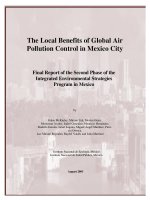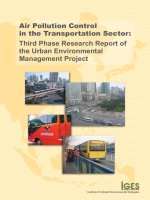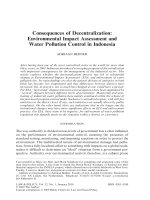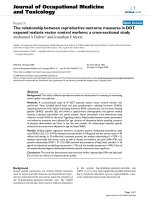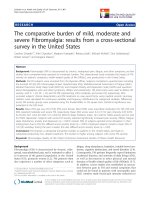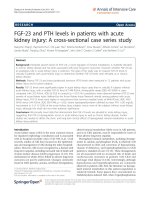Perceptions about air quality and air pollution control in a metropolitan urban residential a cross sectional case study in palembang, indonesia
Bạn đang xem bản rút gọn của tài liệu. Xem và tải ngay bản đầy đủ của tài liệu tại đây (8.23 MB, 142 trang )
THAI NGUYEN UNIVERSITY
UNIVERSITY OF AGRICULTURAL AND FORESTRY
MUHAMMAD DICKY DARMAWAN
PERCEPTIONS ABOUT AIR QUALITY AND AIR POLLUTION CONTROL
IN A METROPOLITAN URBAN RESIDENTIAL: A CROSS-SECTIONAL
CASE STUDY IN PALEMBANG, INDONESIA
BACHELOR THESIS
Study Mode
: Full-time
Major
: Environmental Science and Management
Faculty
: International Programs Office
Batch
: K48 – AEP
Thai Nguyen, 10/11/2020
DOCUMENTATION PAGE WITH ABSTRACT
Thai Nguyen University of Agricultural and Forestry
Degree Program
Bachelor of Environmental Science and Management
Student name
Muhammad Dicky Darmawan
Student ID
DTN1754290011
Perceptions about air quality and air pollution control in a
Thesis Title
metropolitan urban residential: a cross-sectional case study in
Palembang, Indonesia
Supervisor (s)
Dr. Ho Ngoc Son & Dr.rer.nat. Nikki Heherson. A. Dagamac
Abstract:
Air pollution has become a serious environmental problem that plagues many
developing countries in Southeast Asia over the past few decades. This research was
conducted to evaluate the level of public perception about air quality management
strategies and air pollution control in Palembang City, Indonesia. This crosssectional case study deliberately distributed a validated questionnaire among 1514
respondents coming from schools, government offices, industries, laborers and
others. This four-phase study was designed to (1) provide a glimpse on the current
situation of environmental education, (2) determine how students perceived the
situation of environmental education, (3) assess the levels of awareness, attitudes,
and practices regarding air quality and air pollution control among high school
students in Palembang, (4) measure the levels of knowledge, attitudes, practices and
to assess the willingness to pay of residents in the city of Palembang about air
quality and air pollution control. This study provided key major findings that (i)
ii
constructivist teaching programs based on an environmental education approach can
be designed, (ii) students realize that through innovation in the country's current
environmental education system by including a curriculum that emphasizes the
concept of sustainability is urgently needed, (iii) policies that involve improvement
on the curriculum of environmental education in Indonesia are recommended to
increase the proactivity of the younger generation towards a more sustainable
mitigation of air pollution problem in the country, (iv) government policies and
programs related to air pollution control must be immediately emphasized in order
to improve air quality in Indonesia.
Keywords:
AAP, Air pollution, ASEAN, EE, KAP, SDGs, WTP
Number of pages
112
Date of
10/11/2020
Submission:
iii
ACKNOWLEDGMENT
First of all I would like to express my praise and gratitude to Allah SWT, because of
his blessings and grace so that I was able to complete this undergraduate thesis well.
Furthermore, in completing this thesis, of course as a researcher, I cannot be separated
from the obstacles and difficulties. And other things, I am very grateful to all those
who have provided input in various forms for this research. Special thanks to
Dr.rer.nat. Nikki Heherson A. Dagamac for his invaluable guidance and support
throughout this research, also to Dr. Ho Ngoc Son for all the permission and wise
advice given to me, you both are epic supervisors that I ever had. And also I would
like to say a million thanks to Prof. Nguyen The Hung (Thai Nguyen University,
Vietnam), Dr. Condro Wibowo (Jenderal Soedirman University, Indonesia), Dr. Paul
Kristiansen (The University of New England, Australia), Dr.Agr.Sc. Ernoiz
Antriyandarti (Sebelas Maret University, Indonesia), Dr. H. Suhuri, M.Pd (SMAN12),
Wiwi Heriyani, M.Pd (SMAN12), and Mami Lusi Desdemona, S.Pd (SMAN12) for
their assistance as validators in this research. Thank you to every head of government
offices for allowing me to be able to collect data in their office. And a big thanks to
my loving mom (Titin Agustina) and my sisters (Siti Syahra & Ana Putri Pratiwi), I
wouldn’t even be writing a thesis if it hadn’t been for the way you motivated me to
push myself beyond my capabilities. To my best friend Fitria Silfiani Hilmy, thank
you for always supporting me in whatever condition I am, and also to my crazy friends
Ari Zuzu and Pauline Pulpul who always cheer me up when I'm down. And last to my
only roommate in Vietnam (Liham Mulawarman), where we are both struggling to
complete our thesis and still support each other. But in the end WE DID IT BROO !!!.
iv
TABLE OF CONTENT
List of Figures ...........................................................................................................................vii
List of Tables .............................................................................................................................. 8
List of Abbreviations .................................................................................................................. 9
CHAPTER I. INTRODUCTION............................................................................................... 10
1.1. Research rationale........................................................................................................... 10
1.2. Research questions and hypotheses ................................................................................. 13
1.3. Research objectives ........................................................................................................ 16
1.4. Significance of study ...................................................................................................... 18
1.5. Scope and limitations ...................................................................................................... 19
1.6. Definitions of terms ........................................................................................................ 19
CHAPTER II. LITERATURE REVIEW ................................................................................... 21
2.1. Environmental Education ................................................................................................ 21
2.2. Air Quality in Indonesia.................................................................................................. 28
2.3. Social Perceptions about Air Pollution ............................................................................ 30
2.4. Economic Implications ................................................................................................... 32
CHAPTER III. SITUATIONS OF ENVIRONMENTAL EDUCATION ................................... 35
3.1. Materials and Methods ................................................................................................... 35
3.2. Results ............................................................................................................................ 36
3.3. Discussion ...................................................................................................................... 43
CHAPTER IV. STUDENTS’ INSIGHTS ON TEACHING AIR POLLUTION ........................ 48
4.1. Materials and Methods.................................................................................................... 48
4.2. Results ............................................................................................................................ 49
4.3. Discussion................................................................................................................................ 52
CHAPTER V. AAP OF STUDENTS REGARDING AIR POLLUTION .................................. 56
5.1. Materials and Methods.................................................................................................... 56
5.2. Results ............................................................................................................................ 58
5.3. Discussion ...................................................................................................................... 65
CHAPTER VI. KAP AND WTP OF RESIDENTS REGARDING AIR POLLUTION.............. 74
6.1. Materials and Methods.................................................................................................... 74
6.2. Results ............................................................................................................................ 76
v
6.3. Discussion ...................................................................................................................... 85
CHAPTER VII. SUMMARY AND CONCLUSION ................................................................. 93
REFERENCES ......................................................................................................................... 97
APPENDICES ........................................................................................................................ 113
vi
List of Figures
Chapter V. Awareness, attitudes, and practices of senior high school students
Figure. 5.1. Preparation, selection of respondents. ............................................................. 56
Figure. 5.2. Students’ attitudes on air pollution ................................................................... 62
Figure. 5.3. Students’ practices on air pollution. ................................................................. 64
Chapter VI. Knowledge, attitudes, practices and WtP of Residents
Figure. 6.1. Study design and data collection....................................................................... 74
Figure. 6.2. Residents’ attitudes on air pollution ................................................................. 81
Figure. 6.3. Residents’ practices on air pollution. ............................................................... 83
Figure. 6.4. Residents’ satisfaction on air quality ................................................................ 88
vii
List of Tables
Chapter V. Awareness, attitudes, and practices of senior high school students
Table 5.1. Characteristics of the participants. ..................................................................... 58
Chapter VI. Knowledge, attitudes, practices and WtP of Residents
Table 6.1. Characteristics of the participants ..................................................................... 77
Table 6.2. The Willingness to Pay of Respondents............................................................... 84
8
List of Abbreviations
AAP
Awareness, Attitudes, and Practices
ASEAN
Association of Southeast Asian Nations
CO
Carbon Dioxide
EE
Environmental Education
FGDs
Focal Group Discussions
KAA
Knowledge, Attitudes, and Awareness
KAP
Knowledge, Attitudes, adn Practices
NOx
Nitrogen Oxide
PM10
Particulate Matter 10
PM2.5
Particulate Matter 2.5
SDGs
Sustainability Development Goals
SOx
Sulfur Oxide
SWM
Solid Waste Management
UNESCO
United Nations Educational, Scientific, and Cultural Organization
WHO
World Health Organization
WTP
Willingness to Pay
9
CHAPTER I
INTRODUCTION
1.1 Research Rationale
Air is the most important factor in life. However, related to the increase in
population, human needs will also increase significantly to support their survival.
Thus, the need to develop the city, starting from the construction of infrastructure, as
well as the development of transportation and also the number of industries can
contribute to the increase of pollution in the air. Clean air is a basic requirement for
human health, however, rapid economic development in some developing countries
increase the number of industries. Regarding waste released into the atmosphere, air
pollution has become a major risk to public health (Liao et al., 2015). In this case, the
level of air quality will also experience changes associated with increased air pollution
due to human activities, or as changes in air regulation from normal requirements,
such as the entry of pollutants (aerosols and small particles) or the content of other
hazardous substances into the air in a certain amount to a long period of time. This
now in return can affect air quality, which can determine the level of human health,
animals and plants (BPLH DKI Jakarta, 2015).
The city of Palembang or more commonly called the City of empek-empek is
located in the South Sumatera Province. The city is famous as a center for Sriwijaya
Kingdom and Sport city. Located in the lowlands with the height of approximately 8
masl (Pemerintah Kota Palembang, 2016). Palembang is currently a developing city in
the fields of infrastructure, industry, housing, education, trade, and transportation.
Along with urban development, it greatly influences the level of demand for
10
transportation on the streets as well as with the many industrial factories operating in
Palembang city. As a developing area that is heading for a new metropolitan city, this
urban area has an approximately 400.61 km2. The availability of business space and
public facilities that make this city as a supporting area for surrounding area. Like
other urban areas population density, traffic density, trade area, home industry can be
found here. The high intensity of those activities can cause air pollution in this city.
The total population of Palembang city in 2017 reached 1.643.488 people (Badan
Pusat Statistik kota Palembang, 2018). In fact, this could be highly the scenario in
many urbanized areas in Indonesia, particularly, Palembang.
Population density in Palembang city is not ideal, the average density reaches
4.052 people per square kilometer. This condition is considered prone to cause social,
economic, and environmental problems. With the increasing number of the population
comes with an increasing number of vehicles. In November 2017, the number of
vehicle in Palembang city reached 667.786 vehicles with details 458.805 motorcycles,
24.589 freight cars, 183.014 passenger cars, and 1.378 bus, with a number of large and
medium-sized of companies as many as 69 operating in Palembang city (Badan Pusat
Statistik provinsi Sumsel, 2017).
The increased number of vehicles and industries potentially may increase air
pollution in the environment (Liaquat et al., 2010). According to Indonesia’s
Constitution number 32 year 2009 concerning Protection and Management of Natural
Environment, natural environmental pollution is the entry or inclusion of living things,
substances, energy, and other components into the environment by human activities so
that it exceeds environmental quality standards which have been set. Air pollution
11
generated by vehicles exhaust gases particularly occurs on protocol roads, which is the
main road in big cities as traffic center (Wakhid, 2018).
Smoke pollution is an increasingly severe public health problem throughout the
world, including in the city of Palembang, where environmental damage has
accompanied rapid economic growth. The fundamental cause of smog is a high
concentration of fine particles (PM 2.5) or aerosol pollution which is mainly caused by
coal combustion, vehicle exhaust, and industrial emissions (Minghui et al., 2019).
In other cases, forest fires always occur every year in the province of South
Sumatra, so that it gives an impact in the form of smog to several cities in south
sumatera province, including Palembang city. Based on data from the South Sumatra
Health Office (DKSS, 2019), it states that the number of respiratory disease sufferers
in South Sumatra in January - July 2019 reached 312,038 people. Even Palembang city
became the highest area with the number of sufferers of respiratory disease reaching
92,416 people.
In spite of this factual information regarding air pollution and urbanization in
Palembang, there was no information on the perception of Palembang residents in
terms of such environmental issues. According to Qian et al., 2016 KAP (Knowledge,
Attitudes, Practices) survey is a representative study of a certain population, which
aims to collect data about what is known, believed, and carried out in relation to a
particular topic. This is an important element of ambient air pollution control, because
currently, there is limited information available about the KAP perceptions of the
residents of the city of Palembang regarding air pollution. Although several studies
have investigated public awareness about air pollution and its adverse effects on health
12
in several cities in Asia, Liu et al. 2017., Wang et al. 2015., Liao et al. 2015., and Qian
et al. 2016., while the Palembang city investigation has never been conducted.
Therefore, this study focuses on the city of Palembang as an example to understand
and identify the factors associated with the knowledge of Palembang residents about
current ambient air pollution, and how their attitude towards air pollution control, and
protection practices in Palembang, as well as the willingness them to pay for
improvements in air quality. Furthermore, in order to assess the public’ enthusiasm
regarding improvement of environmental condition, the conception of Willingness to
Pay (WtP) is introduced. Wtp is an intention when respondents are asked to state
whether they are willing to pay for non market product. The main purpose of WtP was
applied to bridge the gap between environment and social economics (Rong et al.,
2018). All of these information can be very important particularly in creating
environmental assessments and management strategies that the local government unit
in Palembang needs to enact to mitigate the increasing problem of air pollution in the
future.
1.2 Research Questions and Hypotheses
This research study was designed to integrate the perceptions of different
stakeholders of Palembang city who play an important role in addressing
environmental problem; four themes were used to show the different aspects of this
research.
1.2.1. Teacher’s perspectives on the environmental education situation in Indonesia
13
Background: Environmental literacy helps to address key challenges in
providing
sustainable
development,
the
active
practice
of
promoting
environmental awareness inside the classroom and innovative curriculum change
among many educational systems. Active participation from teachers will be a
key to providing awareness to students in overcoming the challenges of global
environmental problems such as air pollution, climate change, and others.
Question: What is the situation of environmental education in senior high school
programs in Indonesia?
Hypothesis: Teachers from Palembang can address the current situation of
educating Indonesian students regarding environmental issues
1.2.2. Qualitative assessment of students on environmental education situation
Background: The young generation has enormous potential in the maintenance,
preservation and prevention of environmental pollution. Unfortunately, there is
still a lack of awareness from young generation towards air pollution. In fact,
awareness is important to environmental sustainability, and it is a shared
responsibility to ensure its sustainability in the form of proactive and reactive
actions.
Question: What are the students’ insights on teaching air pollution in Indonesian
classrooms?
Hypothesis: Students qualifies different responses regarding their knowledge
about air quality taught inside the classroom
14
1.2.3. Awareness, attitudes, and practices of students on air pollution
Background: Increasing the level of awareness about major environmental
problems is expected to at least change the environmental apathy and
irresponsible human practices towards nature. These knowledge and awareness
most especially on pressing issues about air quality and air pollution control can
be integrated in environmental education curriculum of many high schools in the
ASEAN region. Since this generation of students is considered to be the next
educated workforce for a developing country that would combat the current
plight against air pollution, baseline information regarding their perceptions
about the problem should be urgently documented.
Question: What is the level of awareness, attitude, and practices of senior high
school students regarding Indonesia’s air quality management?
Hypothesis: The awareness, attitude, and practices of senior high school students
are influenced by demographics
1.2.4. Knowledge, attitudes, practices and WtP of residents on air pollution
Background: The World Health Organization (WHO) has showed that ca. 91%
of the global population lives in places where air quality levels already exceed
the limits WHO have set. These places are characterized from low- to middle
income countries such as those that are positioned in the Western Pacific and
South East Asian region including Indonesia. Nevertheless, as an important
prerequisite for a more sustainable environment and safer public health, clean air
has become a scarce good in many metropolitan cities in the world particularly in
15
developing Asian nations. Besides being considered as a major health problem
that leads to increasing global death caused by chronic respiratory diseases, the
ambient air pollution is also known to create burdening environmental impacts
i.e. formation of acid rain, and ozone depletion. In a situation like this it is very
unfortunate because everyone's awareness in treating the environment in a
pleasant manner and do not care about the impact in the future.
Questions:
-
What is the level of knowledge / awareness, common attitude and Palembang
residents' protection measures in terms of the situation of urban air quality?
-
What is the distribution of working classes that would like to pay for the
improvement of air quality of Palembang?
Hypothesis:
-
The residents of Palembang understand in terms of knowledge, attitudes, and
practices towards air quality management and air pollution control in
Indonesia
-
Indonesian working classes would like to pay for the air quality improvement
1.3 Research Objectives
To address the specific research questions that was raised above, the following
research objectives are formulated for each of the four perception phases of this study.
1.3.1. Teacher’s perspectives on the environmental education situation in Indonesia
To provide a glimpse on the current situation of environmental education at the
senior high school level in Palembang
16
1.3.2. Qualitative assessment of students on environmental education situation
To determine how students perceived the situation of environmental education
in their senior high schools and how the issue of air pollution are tackled in
their conservative classrooms
1.3.3. Awareness, attitudes, and practices of students on air pollution
To interview via face to face and focal group discussions to acquire common
information regarding the knowledge, attitudes, and practices of the sample
populace
To create the first survey that would assess the levels of awareness, attitudes,
and practices regarding air quality and air pollution control among high school
students in Palembang City, Indonesia
With the hope that this research can serve as a ground basis for improving
educational systems and as a reference standard on how environmental issues
should be address in most Indonesian schools
1.3.4. Knowledge, attitudes, practices and WtP of residents on air pollution
Indonesian’s KAP on air quality management and air pollution control
To conduct a survey that will qualitatively measure the level of knowledge,
attitudes, and practices of residents in the city of Palembang about air quality
and air pollution control
17
To calculate the distribution of the sample population and its probable
association to certain age groups, sectoral unit, traveling lifestyle, and current
occupation
Indonesian’s WTP on air quality management and air pollution control
To valuate the proposal of creating environmental measures on air quality
problems in Palembang city
To assess the willingness of the working classes (professionals and skilled
laborers) to financially contribute on mitigation projects regarding air pollution
control
1.4 Significance of the study
This research will be significant to the following;
Students
The results of this study can be used as a material consideration for further
research and study related to air quality and air pollution control in Indonesia
Society
The results of this study is to provides information and encourage people to
change their behaviour towards the nature
Government
The results of this study could be used as an information to make and
implement new regulation in order to have a better sustainable environment
18
1.5 Scope and Limitations
The study was conducted from January to June 2020. During this time period
data collection was performed, analyzed, and interpreted accordingly. Although the
research was able to achieve its goals, there were unfortunate limitations for the study.
(1) Some people may not available to be surveyed and also honesty from the
respondents in answering the questionnaire that might take this result to the failure
result. (2) Some government offices and industries did not allow the researchers to
collect data in their agencies. (3) During the COVID19 pandemic, it caused difficulties
for researchers to collect data, due to instructions from the local government to work
from home and maintain physical distance.
1.6 Definition of Terms
For purposes of clarity and easy to understanding, the following terms are defined in
the context of how they are used in this study.
Awareness, Attitudes, Practices (AAP) is an instrument used to determine the level
of awareness through knowledge, attitudes, and practices.
Adiwiyata Program is an initiative of the Indonesian government that refers to
schools to implementing environmental cultured programs.
ASEAN (Association of Southeast Asian Nations) refers to a regional organization
of Southeast Asia that deals with the economic problems of member countries for
mutual progress.
Environmental Education refers to providing information about knowledge related to
the environment and its problems.
19
Generation-Z also known as millenials, refers to the new generation, those who were
born in the mid-1990s until the early 2000s as the end of birth.
Green Schools refers to schools that develop programs to internalize environmental
values into all school activities.
Knowledge, Attitudes, Practices (KAP) is an instrument used to determine the level
of awareness through knowledge, attitudes, and practices.
Sustainable Development economic development that is conducted without depletion
of natural resources.
Sustainable Development Goals (SDGs) a world program that refers to the welfare of
the world community and preserve nature.
Pedagogy refers to the method and strategy of teaching.
PM 10 Particulate Matter (PM) 10 is a fine particle in the air that measures
10 microns or smaller than that.
PM 2.5 Particulate Matter (PM) 2.5 is a fine particle in the air that measures
2.5 microns or smaller than that.
Willingness to Pay (WtP) is an instrument used to determine the level of willingness
to fix something.
World Health Organization (WHO) is an organization formed by the United Nations
to work together in the field of world health.
20
CHAPTER II
LITERATURE REVIEW
2.1 Environmental Education
Although it sounds cliche, the notion that the current younger generation will
inherit the harsh outcome of environmental degradation brought upon by economic
development might still hold true. In return, they are expected to be the prime forces
that would help alleviate the piling of enormous environmental problems that are
happening nowadays. A number of related studies have reported perceptions of the
younger generation on topics related to the impacts of the current environmental
problems (see Zsoka et al., 2013; Oguz et al., 2010; Lorenzoni et al., 2007) that the
world is facing particularly coming from students of the developing and least
developing countries. For instance, the survey of students have indicated the
increasing awareness of students on the physical impacts brought about by climate
change (Bangladesh, Rahman et al., 2018; Bahrain, Freije et al., 2017), plastic
pollution (UAE, Hammami et al., 2017), renewable energy (Colombia, Edsand &
Broich, 2019) and invasive species (Portugal, Schreck-Reis et al., 2013). Such
awareness can be attributed to the value of environmental educational efforts invested
by many countries throughout the world.
Educating the 21st century learners with the right amount of long-term knowledge
and competitive soft skills is a wise investment for any developing nation that
envisioned a more sustainable livelihood and a better quality of life for its community.
This idea served as a backbone of many international policy discourses, i.e. the United
Nations Sustainability Development Goals (SDGs) 4 that aim to develop “Quality
21
Education” for all the citizen of this world (Kopnina, 2020). The emergence of these
new ideal standards of education every country should provide to its younger
generation necessitated active discussions in the field of environmental education or
EE (Fraser et al., 2015; Potter, 2009). Environmental education is also the main
constituent of the concept that is heavily context dependent in social, cultural and
environmental situations that is sustainable development (Jeronen et al., 2016). Its goal
is to highlight on “education for sustainability” which is not only for environmental
education but for poverty alleviation (Tilbury, 2003), socio-economic development
(Jickling & Wals, 2008), even population and gender issues (Larsson et al., 2010). It is
also expected to promote environmentally sustainable societies throughout the AsiaPacific region (Bhandari & Abe, 2000). Unfortunately, some countries in Asia are
focused more on national development rather than social and ecological sustainability
(Furihata & Ninomiya-Lim, 2017).
Indonesia is considered to be the world’s biggest Muslim-majority country with a
significantly large population size. With really high number of various ethnic groups
that can speak more than 700 living languages, it is obvious that Indonesia is one of
the most culturally diverse countries in the world. Historically, the concept of EE in
Indonesia can be traced back during Suharto’s authoritarian regime. For nearly 30
years in governance, his administration achieved Indonesia’s most rapid economic
growth in the late 1960s including stronger environmental efforts for the country
(Nomura, 2009). In spite of criticisms that the Ministry of Environment received at
that time, environmental education was still initiated in Indonesia beginning with the
university education. At present, both the state owned and private universities in
22
Indonesia are engaging in training and strengthening the research thrust of the country
geared towards finding appropriate environmental solutions to the increasing problems
related to many socio-economic problems of a developing third world country. Among
these efforts are (i) courses that teach environmental impact assessment for university
staff members, (ii) trainings on population and environment for elementary, secondary
highs school teachers and (iii) production of informative educational materials that
could be disseminated to the public. Furthermore, it was mentioned in the book
chapter published by Nomura & Suyono (2014) that leading universities in Indonesia
have been offering environmental undergraduate programs namely environmental
planning and management, environmental laws, geographic information system,
ecology etc. Although environmental education could be integrated in many university
courses in Indonesia, the primary, elementary and high school level in the country do
not yet have an independent subject related to environmental education. Rather,
scouting is encouraged as an outdoor EE activity (Nomura 2009) and environmental
issues are incorporated in the curriculum system in almost all subjects thought at
secondary level of education in Indonesia (Prihantoro 2015). Besides this, a recent
paper of Aprilia et al. (2018), have recognized the development of the so called
“Kitakyushu Eco Model/KEM” on education and society awareness sector at a visual
impairment school in Bandung.
With the continued rising of environmental issues such as loss of biodiversity,
climate change and pollution over the last decade that triggered preparedness for
natural calamities and management of risk disasters in the tropical Southeast Asia, it is
expected that schools in the country have implemented novel teaching strategies to
23
raise more environmental awareness, and risk attitude among the youth sectors. This
expectation is valid enough especially now in an era where so much fake news is
appearing in many digital platforms and many students are vulnerable to
misinformation.
Furthermore, environmental crisis in the modern society is caused by
environmental management that ignored the principle of sustainability. Many methods
have been done to alleviate these environmental crises globally however until now,
there is no instant and quick formula to fix all the damages brought upon by the
continued degradation of natural resources. Therefore, it needs another long term
formula in solving this natural problem. One way that can be used is by educational
approach. According to Herdiansyah et al. (2016) the involvement of environmental
development could be done through two kinds of approaches – project approach and
motivation approach. The first approach (project) is based on redesigning existing
curriculum that would focus in contributing to the success of the student learning
experience. The implementation of this new design involves an evolutionary
improvement of the existing traditional curriculum with gradual modifications (Drinka
et al., 2019). On the other hand, the second approach (motivation) is characterized of
an educational environment that has a set of spatial-objective, social, psychological
and pedagogical influences as objects of analysis (Kislyakov, 2017). Although the
motivational approach may spend a longer time, Pahl et al. (2017) have noted that it
will yield more positive effects because the target students will gradually change their
attitude and behavior in persuasive manner. The student’s behavior of ignoring
environmental problem will turn into attitudes that will always grow and culminate in
24
stability of environmental involvement. Nevertheless, both approaches can be
integrated through education systems that would enforce not just environmental
awareness but as well as environmental values. These may served as the backbone of
the younger generation to engage themselves on many international policy discourses.
The younger generation are expected to actively participate and become game
changers for the environmental crises that our world is facing nowadays. In spite of
many social digital platforms that allowed the younger generation to learn and
communicate many of their environmental concerns, advocacies, and inquiries,
conservative education systems, especially on many developing countries in Southeast
Asia, are still reliant on traditional education inside the classroom.
In particular is the Muslim dominated country of Indonesia whose rapid
urbanization has occured in less than two generations (Dethier, 2017). This
urbanization has also boosted the consumption needs of the Indonesian populace. In
particular is energy consumption coming from industries and normal households,
wherein most of the sustainable energy supplies are needed to be maintained and
improved (Alam, 2016). According to Santosa et al. (2008), the rapid development of
Indonesia was in fact heavily fueled by fossil fuels, especially oil, followed by natural
gas and coal. The exploitation of fossil fuel in “fueling” the development of the
country resulted in significant environmental quality degradation. Air pollution is
perhaps Indonesia's most severe environmental problem. The construction of
infrastructure, as well as the development of transportation and also the number of
industries can contribute to the increase of pollution in the air (Ummi et al., 2019;
Setiawan et al., 2018; Wijayanti et al., 2018; Saudi et al., 2019). Clean air is a basic
25

